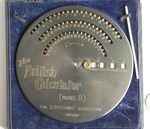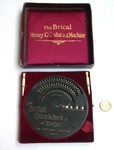

Description
Video
History
Variations
Advertisements and Articles
Patents
Links
The British Calculator is an adding machine for British currency. It is disk-shaped, about 13.5 cm in diameter, and 9mm thick. There are three curved slots exposing part of three concentric rings. The outer ring counts ha'pennies, the middle ring counts shillings, the inner ring counts up to 49 pounds. There are numbers next to the slots, and you can insert a stylus into the slot next to a number and move the ring clockwise until you reach the end of the slot. This adds the chosen number of ha'pennies, shillings, or pounds. There are small windows to the right of the centre in which you can see the current total. The rings carry automatically, and the inner ring carries to a small wheel that counts multiples of 50 pounds.
My British Calculator has serial number 1681 stamped on the side, as well as "T. J. Marshall & Co., Mnfrs.". It was probably made in 1907.
The slots allow you to enter any value up to £19, 19s 11½d, and the register can total up to £499, 19s 11½d. There is no clearing mechanism, but some of the teeth of the rings are marked with a red dot, and using the stylus to pull that tooth to the end of the slot will set that ring to zero. To set the whole register to zero you must set the outer, middle, and inner rings to zero in that order, and then turn the small knob until the small counter wheel is zero.
I have a second BriCal which was made later, and has the serial number 30,160. It is mechanically identical to my older one, except that it has a different engraving on the front, and does not have the T. J. Marshall & Co mark on the side. Note that the front now says "The British Calculators LTD.", and they probably used the same template as before, but added "s LTD." on the end with a second template, as the spacing before the s seems a bit too large. Below that is the new name for this machine, the BriCal. The small wheel for counting multiples of £50 is missing its knob and spring, so does not work properly. The box has a lid fastened with push-buttons, has a red lining, and includes the two bone styluses.
Below is a video I made that demonstrates the British Calculator and shows how it works.
According to the patent for the British Calculator, it was invented in 1906 by Herbert Dickinson, Engineer, and Mabel Dickinson, Married Woman. The patent was filed in 1905, with an addendum in 1906 that contains the design of this calculator.
Herbert Young Dickinson, 1859-1936, has a variety of patents to his name, and the earliest mention I found is from 1885 of a machine that prints the notes played on a piano. Mabel Dickinson (1877-1939) was born Alice Mabel Warren. Apparently Herbert and Mabel only became officially married in 1908, but it is not entirely clear whether either of them had a previous marriage, nor whether Mabel is the mother of the son Reginald Young Dickinson who was born in 1897. Reginald is listed as co-inventor on some of Herbert's later patents.
T. J. Marshall & Co was a company of papermakers' engineers founded in 1792 by John Marshall. They made machines for producing paper, invented the now standard process for making watermarks, and made the "dandy rolls" which are used in that process to press the watermark into the pulp. In 1905 the company was still a family business, run by T. Allen Marshall and C. Dudley Marshall.
It is likely that the Dickinsons brought their calculator to T.J. Marshall & Co to be manufactured. Between the initial filing of the patent and the filing of the complete specification their address changed, moving across London from Kew to Stamford Hill. The latter is within walking distance from the Campbell Works at Stoke Newington, where T.J. Marshall were located.
In 1907 a separate company was set up, British Calculators Ltd., to manufacture the British Calculator and other calculators. It was founded by the Dickinsons and the Marshalls, and the managing directors were Herbert Dickinson, T. Allen Marshall, and J. Spottiswoode. The company operated from premises just over the road from T.J. Marshall Ltd.
It is unclear exactly when British Calculators Ltd. stopped trading. According to one site the company was liquidated in 1910, but adverts appeared until at least 1912, and in 1914 they took part in the Napier Tercentenary Exhibition in Edinburgh. I found no mention after that, so it may be that the first world war caused them to close. Herbert and Mabel Dickinson were granted various other unrelated patents from 1911 onwards, so presumably they had moved on by then.
In 1920 the calculator was revived by the New British Calculators Ltd. It is not clear where this new company was based and who was involved, but Herbert Dickinson together with James Robert Dunn filed a patent in 1920 with an improved carry mechanism, so it is quite possible that they were responsible. The new company seems to have disappeared after a few years too.
First versions of this adder have 3 slots that were placed symmetrically, extending the same distance to the left and right. The slots for the two outer rings are exactly a third of a circle, and the number scale is repeated three times along the ring. The inner ring has a scale from 0 to 49, which is not repeated. On the earliest versions the slot for it went from 0 to 15, about a third of a circle, but they soon lengthened it to go from 0 to 20, so its slot covers just over 2/5 of a full circle. The third ring carried over to a small wheel, allowing the register to display any monetary value up to £500.
This version was called the model B, and this was engraved on the front of the machine. It is not known if there was a model A, but a model C was made. This had three rings or discs placed side by side instead of concentrically. It is very rare, probably because customers preferred the larger range and the compactness of model B.
By the time that British Calculators Ltd. came into existence, the £500 range was apparently deemed inadequate so they tried to extend it. The small wheel could not be easily enlarged because of the central screw, so it was replaced by a fourth ring. This ring is smaller, and its teeth are proportionally closed together. The fourth ring counts up to £2000 in steps of 50, but its slot goes from 0 to 500, or just over a quarter of a circle.
To extend the range further, they made a variant which added a vertical slider on top of the existing case, but connected such that it received carries from the fourth ring. The limited space between the slots and the front edge of the machine meant that the slider could only count up to £20000 in steps of 2000.
The closely packed teeth on the rings can make it rather fiddly to work with, so the next variant they made had the teeth on most of the rings spaced further apart. The two outer rings could then only have their scale repeated twice on each ring, and their slots had to extend for half the circle. The third and fourth rings also had their slots lengthened to half the circle. To keep the slots away from the register window, they were no longer arranged symmetrically but extended further to the left. This variant sometimes also had a vertical slider added for extra range. They also made BriCals with the older arrangement of three rings and a wheel in which the rings have the extended asymmetric slots of the four ring version, presumably as a cheaper model.
After that, variants were made with five or six rings. These have a larger diameter of about 15cm or 19cm instead of 13cm. It seems that the rings were added in order to make it easier to use rather than to extend the range. Having rings with different scales is confusing, and you have to add the numbers in the windows to get the total number of pounds. The five- and six-ring versions simply used scales of 0-9 on the inner rings so that the windows display single digits and the value can be read off directly. It seems that the scales were generally repeated 3 times on each ring since the slots are about a third of a circle. The outer two rings for the shillings and pence are still half a circle.
The above all handle British currency. There were also versions made for handling imperial weights, or for decimal currency like US dollars. These are mostly based on the 5 or 6 ring configuration, though there was even a 7 ring version.
The inscription on the front of the machine has also gone through many variations. The first versions by T.J. Marshall had "The British Calculator / (Model B) / for compound addition / Patent". When the new company was set up it changed to "The British Calculators Ltd / The 'BriCal' / for compound addition / Patent". It looks like they used the same engraving template for this, as the letter spacing of the last letter of Calculators seems a little wide. This was then shortened to just "The 'BriCal' / for compound addition / Patent", and shortened again to "The 'BriCal' / Patent". Later a Brical Adding Machines logo was used.
Apparently British Calculators Ltd. also made an adding machine called Kosmos. This had a full keyboard for British currency, and a crank on the side to perform the addition. By pressing down a clearing button and turning the crank the register is reset. Little is known about this machine other than the entry in Die Rechenmaschinen by Ernst Martin.
I found various advertisements and articles in online archives. Here are the ones related to T.J. Marshall & Co.
Here are those related to the BriCal and British Calculators Ltd. Note that when the calculator was shown at various exhibitions in 1906, they already presented themselves as British Calculators even though the limited company had not yet been set up.
Finally a few items from the 1920s, mostly related to New British Calculators Ltd.
Lastly a few newspaper articles mentioning Herbert or Mabel Dickinson.
Herbert (Young) Dickinson has many patents to his name. He seems to have
started in the 1880s, but the digitised records do not go back that far.
His patents include a toy figure,
(US 444,088),
lathing machinery
(GB 1893/23278),
an ice cream dispenser
(US 517,847),
a zoetrope
(GB 1899/09954),
cash registers
(GB 1901/08706,
GB 1904/24854),
and window blinds
(GB 1902/00486).
After the BriCal came some patents for stereoscopic imaging
(GB 1911/03552,
GB 1913/00971),
practice bullets
(GB 1914/02724)
and impact fuses for the war
(GB 1915/02179),
and smoke detectors
(GB 182,918,
GB 210,860).
Here are the patents relating to the BriCal.
| Patent | Filing date | Priority date | Name | Description |
|---|---|---|---|---|
| GB 1905/12088 | 09-07-1905 | 09-08-1906 | Herbert Dickinson, Mabel Dickinson | Improvements in Counting or Adding Machinery |
| GB 166,279 | 18-08-1920 | 21-07-1921 | Herbert Dickinson, James Robert Dunn | Improved carry mechanism. See also: FR 528,201. |
© Copyright 2018-2023 Jaap Scherphuis, mechcalc a t jaapsch d o t net.